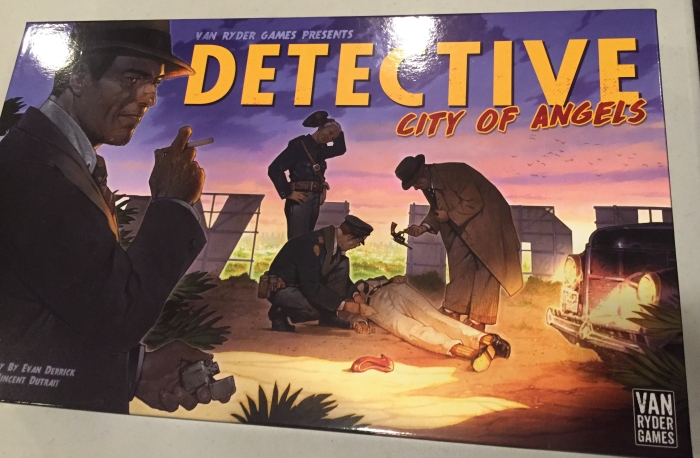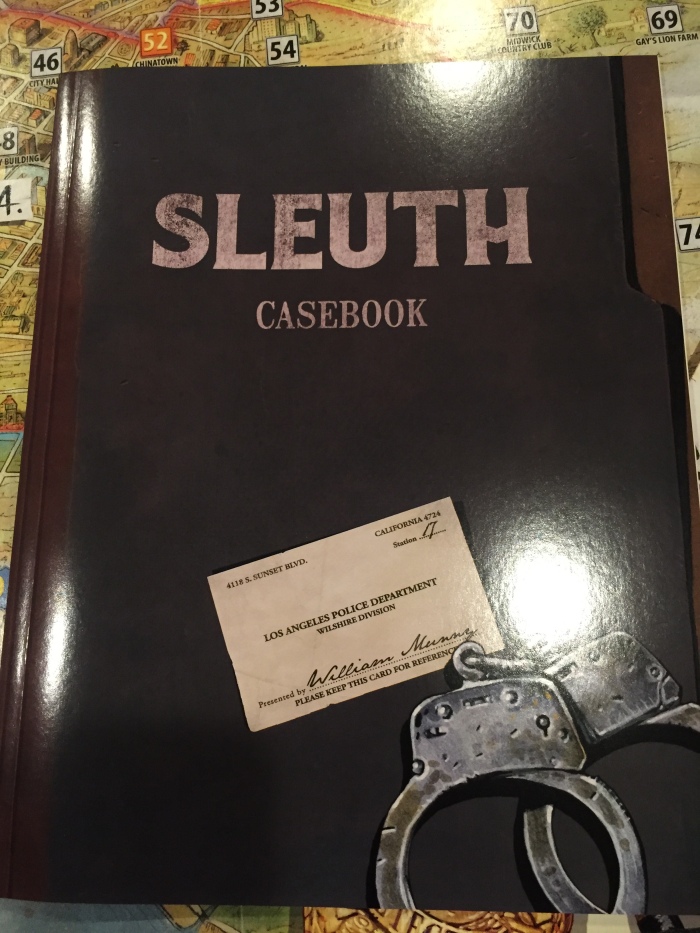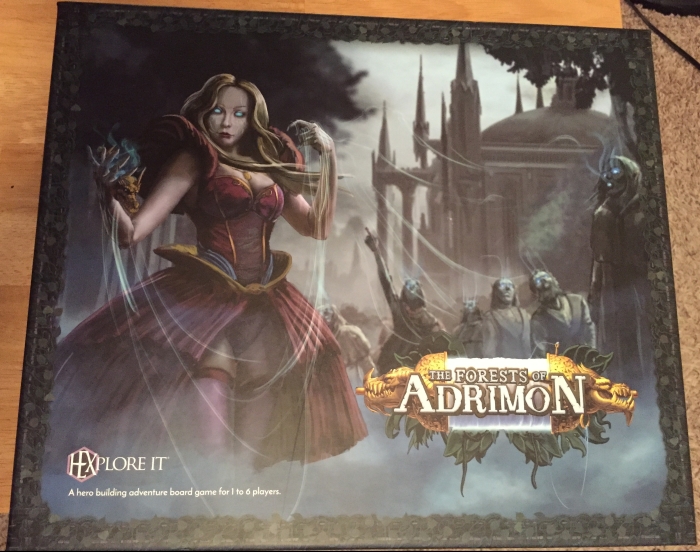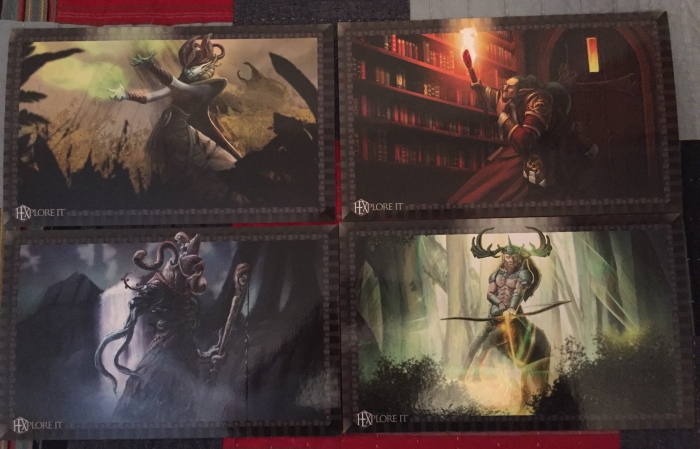
To be clear: this is a review of Detective: City of Angels by Van Ryder Games (see picture above) and NOT Detective by Portal Games.
I was one of the Kickstarter backers for Detective: City of Angels. And this games was very late: so late that it made Zee Garcia’s “Most Anticipated Games” twice: once in 2018 and once in 2019. It was supposed to deliver in Sept. 2018, and it delivered in August 2019.

This game sat on my shelf for almost a month after I got it. Every time I went to play it, I noticed “Oh, it’s a one vs. many or one vs. competitive. Why did I get this?” Until one day I opened the rules and reminded myself why I got it:

Oh ya! There is a cooperative mode. Most others reviews will focus on the Classic Mode or Head-to-Head Mode. Nope. We will only focus on this as a cooperative game. (This is a cooperative games blog after all).
Unboxing

When I first opened the box, I was blown away by the art on all the little character standees! So colorful! And the case boxes on the side were really cool!

There are a lot of tokens: it turns out, you don’t use nearly as many for the cooperative game (you don’t use Snitch or money or A-L). The Stress markers (upper right) and Final Guess are ONLY used in the cooperative game.

This is definitely a deduction game with mystery aspects! Players will be filing out a case sheet … well, only one shared case sheet for the entire cooperative team (although we still each took our own notes separately when we played). The Case Sheet is how you keep track of information you have uncovered.

The Board is HUGE and barely fits on my table. In fact, when we played, all 4 players came to the front side or the edges of the table, while the board draped over the edge! This board is huge! And really cool …

Each player gets a briefing book …although technically, you could all probably share one in the cooperative game. It makes it nice to follow along.

This is the most important book in the cooperative game: players read sections of very thematic text out of this to gather information.

The cards (and these are ONLY USED IN THE COOPERATIVE GAME) give the number of the section to read from the casebook when you are ready to investigate “something”.
The Chisel and Classic Mode Components

There are a LOT of components (see below) related to the Chisel and the competitive mode. You don’t need those components for cooperative play (although you WILL use the chisel book above to look at the final answer). In competitive mode, the Chisel is sort of like a Dungeon Master (DM), running the adventure and reading thematic text and passages. In the cooperative game, the reading is shared among the players, and rotates every turn … there is no DM: the players are playing against the game.
There are a lot of tokens not used in competitive mode:



The Rulebook
The rulebook is very colorful and very good. The only problem is that the rulebook is geared towards Classic Mode (competitive mode) and the cooperative mode is discussed only after all the Classic Mode are discussed (and a lot of those rules aren’t even relevant).
So, I struggled A LITTLE with the rules. But, the Sleuth Mode did have its own section (and a pretty big section) for the cooperative play. It even showed a set-up picture for JUST the cooperative play!

I wish the game had been geared towards cooperative play (Sleuth Mode) rather than competitive play (Classic Mode), but I was able to get to the cooperative mode fairly quickly.
Gameplay


The game plays by each character having 4 actions (represented by the 4 cubes). Each player gets a chance to perform his 4 actions and play rotates around the board. After you perform your actions (move, search suspect or location, question), the day counter (on far right of board) moves down. If it makes it to Day 1 (or the Final guess token, which moves up when you get too much stress), then you need to solve the WHO DUNNIT, HOW DO IT, and WHY DO IT (suspect, weapon, motive). If you fail, then you can go into overtime and take a few more turns. And you solve the case or you don’t!
The active player performs his actions, while the player to his left consults the Sleuth Cards (for what happens when he searches, or questions), and the player to his right reads from the Sleuth book, describing “What happened.”
The game plays a LOT like Agents of SMERSH or Tales of the Arabian Nights: The game is story driven with a lot of reading. However, there is also a lot of thematic air as well! You don’t just read: players get to make a choice! After the text is is read, you may challenge it! You may think the suspect is lying and shake them up! Sometimes, you get new info (“I knew they were lying!”) … and sometimes you cause STRESS (“I told you I wasn’t lying!!! I’m calling the cops!”) If you cause TOO MUCH STRESS, then you shorten the game (make the final guess marker move up).
I thought it was very thematic to be able to “rough up” your suspects.
Solo Play

So this games works great as a solo mode. The solo mode is essentially the cooperative mode, but with only 1 detective. So congratulations to Detective: City of Angels on following Saunders’ Law: All cooperative games need a viable solo mode.
I played solo, I learned the game, I had fun … even though I did lose. I worried about story-telling part: usually reading lots of text for a solo player doesn’t work well for me (like in Robit Riddle or Crusoe Crew), but because I had a choice to “challenge” the response after reading, I felt like I had more choice! It kept me engaged.
This game worked well as a solo game.
Multiple Players

The game worked very well with multiple players! Even though there’s only one active player, someone is always doing something! One player is active taking their turn, one player is consulting the Sleuth card (to figure where to read in the Sleuth book), and one player is reading the Sleuth book! Even in a 4 player game, the 4th player can be taking notes on the case cards!

Everyone is active! And then the mystery itself was interesting!
The Cases

To be clear, this is a game of deduction and solving a mystery (I’ve only seen murder so far). This isn’t Clue or Awkward Guests where you eliminate things with precision (“Oh here’s a card: cross off the jealousy icon”). You have to listen to the WAY certain suspects answer the questions, you have to look at the evidence carefully, and you have to understand something of human nature. If you want a mystery that solved precisely and methodically like Clue, this may not be for you. You really have to put the pieces together by understanding human nature as well as the evidence!
There are certainly elements of deduction that are very important, but I felt like really finding the final solution required looking below the surface.
Conclusion

At the end of the day, this is a fantastic game. I liked it as a solo game and my friends and I all enjoyed this as a cooperative mystery. (It came up several times: we like this MUCH MORE than the Portal Games Detective! My group did not like the Portal game, as it felt too much like work). We all had FUN!
Detective: City of Angels plays a lot like Agents of SMERSH and Tales of Arabian Nights. There’s a lot of story, and players read from the storybook. But there’s a mystery to unlock! That’s both boon and bane! That same mystery that makes Detective: City of Angels so much more thematic and engaging than Agents of SMERSH and Tales of Arabian Nights also limits Detective: City of Angels’ replayability. There’s only 9 Cases that come in the core box! And once you have played them, you are really done with them (unless you come back years later). Luckily, there is one expansion already done and another expansion on Kickstarter as we speak!
At the end of the day, I would probably give this an 8 on the BoardGameGeek scale. Fun game.



























